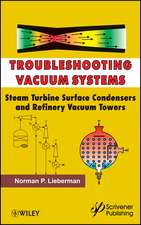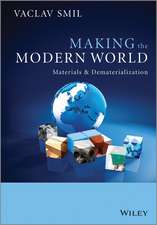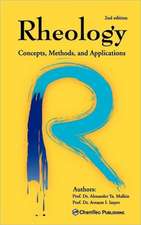Sensors Based on Nanostructured Materials
Editat de Francisco J. Arreguien Limba Engleză Paperback – 8 oct 2011
| Toate formatele și edițiile | Preț | Express |
|---|---|---|
| Paperback (1) | 642.36 lei 6-8 săpt. | |
| Springer Us – 8 oct 2011 | 642.36 lei 6-8 săpt. | |
| Hardback (1) | 646.94 lei 6-8 săpt. | |
| Springer Us – 23 oct 2008 | 646.94 lei 6-8 săpt. |
Preț: 642.36 lei
Preț vechi: 755.72 lei
-15% Nou
Puncte Express: 964
Preț estimativ în valută:
122.93€ • 127.87$ • 101.49£
122.93€ • 127.87$ • 101.49£
Carte tipărită la comandă
Livrare economică 14-28 aprilie
Preluare comenzi: 021 569.72.76
Specificații
ISBN-13: 9781441946010
ISBN-10: 1441946012
Pagini: 336
Ilustrații: XX, 380 p. 100 illus.
Dimensiuni: 155 x 235 x 18 mm
Greutate: 0.47 kg
Ediția:2009
Editura: Springer Us
Colecția Springer
Locul publicării:New York, NY, United States
ISBN-10: 1441946012
Pagini: 336
Ilustrații: XX, 380 p. 100 illus.
Dimensiuni: 155 x 235 x 18 mm
Greutate: 0.47 kg
Ediția:2009
Editura: Springer Us
Colecția Springer
Locul publicării:New York, NY, United States
Public țintă
ResearchCuprins
Carbon Nanotube and Fullerene Sensors.- Non-carbon Nanotubes: Hydrogen Sensors Based on TiO2.- Alternative Nanostructured Sensors: Nanowires, Nanobelts, and Novel Nanostructures.- Nanosensors: Controlling Transduction Mechanisms at the Nanoscale Using Metal Oxides and Semiconductors.- Quantum Dots for Sensing.- Nanostructured Magnetic Sensors.- Encapsulated Probes.- Optical Fiber Sensors Based on Nanostructured Coatings.- Nanostructured Flexible Materials: Metal Rubber™ Strain Sensors.
Recenzii
From the reviews:
"This book can be recommended to anyone who wants to have an overall picture of the symbiosis between nanoscience and sensing: students, technical personnel and scientists working in many different fields … . Sensors based on nanostructured materials provides a good insight into the world of sensing with nanostructured materials. It provides a nice overview of fundamental principles, fabrication processes of the sensing devices and applications." (Rosario Pereiro, Analytical and Bioanalytical Chemistry, Vol. 394 (5), July, 2009)
"This book can be recommended to anyone who wants to have an overall picture of the symbiosis between nanoscience and sensing: students, technical personnel and scientists working in many different fields … . Sensors based on nanostructured materials provides a good insight into the world of sensing with nanostructured materials. It provides a nice overview of fundamental principles, fabrication processes of the sensing devices and applications." (Rosario Pereiro, Analytical and Bioanalytical Chemistry, Vol. 394 (5), July, 2009)
Textul de pe ultima copertă
Sensors Based on Nanostructured Materials presents the many different techniques and methods of fabricating materials on the nanometer scale and specifically, the utilization of these resources with regard to sensors. The techniques which are described here are studied from an application-oriented perspective, providing the reader with a broader view of the types of nanostructured sensors available. The material covered includes:
Sensors Based on Nanostructures Materials is suitable for academic and industrial research scientists as well as engineers.
- Sensors based on carbon nanotubes and fullerenes
- Non-carbon nanotubes arrays
- Nanowires, nanocombs, nanobelts, nanorods, nanoswords and nanosquids
- Metal oxides and semiconductors: nanotemplates, nanowires and nanocrystals
- Quantum Dots
- Nanostructured magnetic sensors
- Encapsulated probes
- Optical fiber sensors based on nanostructured coatings
- Nanostructured sensors on flexible substrates
Sensors Based on Nanostructures Materials is suitable for academic and industrial research scientists as well as engineers.
Caracteristici
Complete discussion of sensors based on carbon nanotubes including sensing applications of carbonanotubes, gas, volatile organic compounds, flow, pH, glucose, biomolecules detection and other biological sensors Coverage of Nanowires, Nanobelts, and Novel Nanostructures and sensing applications such as gas, electronic noses, and chemical warfare agents Discusses Nanocoatings on optical fibers including sensing applications such as humidity, gas, volatile organic compounds and biological recognition Discusses the relatively new encapsulated probes for sensing and applications such as pH, calcium, oxygen, glucose and intracellular imaging Complete coverage of Biosensors by means of nanostructured materials and types of nanostructured biosensors such as DNA-protein conjugates, template-imprinted nanostructures, nanostructured electrodes for biosensing and methods of synthesis Includes supplementary material: sn.pub/extras













